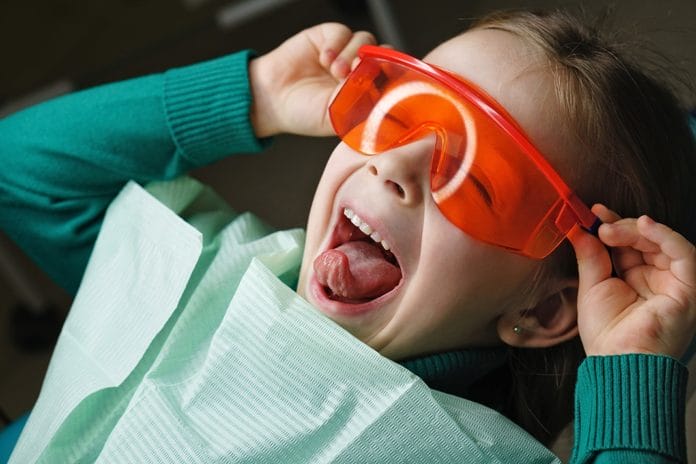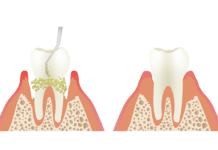Do you remember your first dental visit? I do not; I was apparently too young to have any memory of that momentous occasion. However, thanks to my chosen profession, I am a part of many kiddos’ first dental visit!
The American Dental Association recommends the first dental visit by age 12 months or six months after the appearance of the first tooth.2 Some may question the need for their child to be seen at such an early age. Early dental visits, though, can maximize the chances for children to grow up with healthy, happy smiles, and ultimately a healthy body. Preventive dentistry is especially important for kids whose teeth, mouth, and gums are still developing.1 They help him or her chew, speak, and smile.
Baby teeth also hold space in the jaws for permanent teeth that are growing under the gums. When a baby tooth is lost too early, the permanent teeth can drift into the empty space and make it difficult for other adult teeth to find room when they come in. This can make teeth crooked or crowded. That’s why starting infants off with good oral care can help protect their teeth for decades to come.2
Treating cavities and abnormalities early rather than waiting for dental problems to fully develop saves patients time, pain, and money, according to experts. Even more importantly, A healthy mouth helps children maintain better self-esteem, nutrition and overall health.1
Making it Fun
When those little people show up on my schedule, I have learned it is not a one method works for all type of situation. These patients are all so very different! I try my best to make it a fun and stress-free situation for both patients and parents.
Remind parents to try and avoid making appointments during normal nap time or after school when kids may be tired, and to never bring a child to the dentist if they are ill or not feeling well. Some children will act as if they have done it all before and march right in, and we get down to the business of assessing caries risk, checking growth and development, reviewing oral hygiene instructions, cleaning teeth, and placing fluoride.
Others do not, however, and for those patients, I take a slower approach. I always introduce myself and try to engage the patient as well as their caregiver. I use a show-and-tell approach with nonthreatening nomenclature about the dental chair, tooth tickler, Mr. Thirsty… you get the idea. If the child is reluctant to get in the chair, I encourage Mom, Dad, or a grandparent to hold the child in their lap in the chair to help the child feel more comfortable and get used to the dental appointment.
I try to make the child a big part of the appointment, letting them touch and see all the things we will be using, asking for their preference of toothpaste flavor and toothbrush color, trying to make it fun for them. Praise usually goes a long way! Even if it is something as simple as opening their little mouths for 30 seconds, those 30 seconds can be crucial in assessing their oral health.
Always reward them for their efforts of being there. Balloons, a visit to the treasure chest, or whatever your office uses to reinforce that the dental office is a good and fun place to be can send a big message to those patients. One thing I don’t do is push the child beyond their comfort level, especially the younger ones. If there isn’t an area of concern or a problem the child is having, and they are not receptive to the prophy and exam process, we will try again in six months; 180 days makes a huge difference in the life of a one- or two-year-old.
Kiddo Education
Even though it is imperative for children to be seen early by the dentist or hygienist, what’s more important is what goes on daily in their homes. Brushing teeth can be a ritual that some kids and parents do not look forward to. I get it; some kids don’t want to brush their teeth at all. Others may just want to do it all themselves, and others may just be too busy with their toys to slow down for something as boring as oral hygiene.
It’s our responsibility to try and help educate parents with tips and tricks they can use at home to help ensure that they are caring for their little one’s teeth in the best way possible. Here are a few examples you can share with parents to help make brushing a little more fun at home:
- Let them brush with you – Kids like to mimic what they see, so bring them into the bathroom with you when you are brushing and let them copy your actions.
- Use the right size brush – If it’s too big or too small, it will be ineffective, so make sure that the toothbrush size is appropriate for the age of the child. Let them be involved in what type or color brush they want. It makes it “theirs” and hopefully will encourage the brushing routine.
- Use only a pea-sized amount of low fluoride toothpaste – Let your child be involved with picking out the toothpaste. It may be the flavor, the packaging, or the character on the front. Whatever the reason, if the child has picked it out, they may be more excited about using it.
- Get a timer − It is recommended to brush for at least two minutes, so setting a timer lets the child know when he/she is finished and gives him/her a sense of accomplishment when they brush the whole time.
- Brush to songs − Crank up a favorite tune on your phone and brush until it’s over, or you can use the tune of “Row, Row, Row your Boat,” but change up the words to “Brush, Brush, Brush your teeth.”
- Reward their efforts − It can be as simple as a sticker, a high five, watching a favorite cartoon or whatever encourages the little one to want to repeat the process every morning and night.
In addition to brushing twice daily and cleaning in between teeth when teeth begin to touch, parents also need to be aware of the nutritional aspect of dental care, including the following: Try to encourage eating healthy nutritious snacks, limiting sweets for special occasions or mealtimes. Infants should only have formula or milk in bottles and should finish them before naps or bedtime. Avoid using sugared water, juices, or soft drinks in bottles.3
Armed with this knowledge of how to care for their children’s teeth and strategies to use when trying to start an oral hygiene routine at home, hopefully, our little dental patients will get a great start on their way to a happy, healthy smile that lasts them a lifetime.
Now Listen to the Today’s RDH Dental Hygiene Podcast Below:
References
- More than 20% of U.S. Kids Have Not Had Preventive Dental Care. The Annie E. Casey Foundation. Retrieved from https://www.aecf.org/blog/more-than-20-of-us-kids-have-not-had-preventative-dental-care/
- Baby Teeth. Mouth Healthy: American Dental Association. Retrieved from https://www.mouthhealthy.org/en/az-topics/b/baby-teeth
- Nutrition. Mouth Healthy: American Dental Association. Retrieved from https://www.mouthhealthy.org/en/babies-and-kids/nutrition












